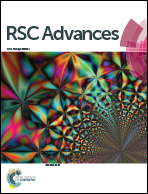Conversion of 5-[(4-nitrophenyl)azo]salicylate–metal complexes into nitrogen-doped nanoporous carbons for supercapacitor applications†
Abstract
Nitrogen-doped nanoporous carbon has been produced by the carbonization of a 5-[(4-nitrophenyl)azo]salicylate–zinc complex, which is prepared by mixing Zn2+ ion and sodium 5-[(4-nitrophenyl)azo]salicylate in aqueous solution. Furthermore, zinc metal was added to the complex before carbonization to improve the electrochemical performance. It was found that the zinc metal-2:1-900 sample exhibits the best capacitive behavior. It has amorphous features and a porous structure, and displays a large Brunauer, Emmett and Teller surface area of 1177.2 m2 g−1, a total pore volume of 0.89 cm3 g−1, and a nitrogen content of 3.63%. Based on the three-electrode system measurement, the zinc metal-2:1-900 sample delivers a large specific capacitance 266.2 F g−1 at 1 A g−1 and has good cycling stability. It also has a large energy density of 33.4 W h kg−1 for a power density of 0.5 kW kg−1 when measured in a two-electrode system. More importantly, the superior electrochemical performances obtained at the operational temperatures of 25/50/80 °C in a two-electrode system can greatly increase their application as a practical supercapacitor. The present synthesis protocol can be extended to prepare other complexes such as 5-[(4-nitrophenyl)azo]salicylate–magnesium/calcium/aluminium, which also readily yield nanoporous carbons.
![Graphical abstract: Conversion of 5-[(4-nitrophenyl)azo]salicylate–metal complexes into nitrogen-doped nanoporous carbons for supercapacitor applications](/en/Image/Get?imageInfo.ImageType=GA&imageInfo.ImageIdentifier.ManuscriptID=C4RA02902J&imageInfo.ImageIdentifier.Year=2014)

 Please wait while we load your content...
Please wait while we load your content...